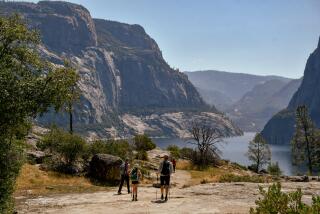Rafting the Middle Fork of the American River
- Share via
I recently returned from a hair-raising day of rafting on the Middle Fork of the American River, which the outfitter’s website bills as “one of California’s premier adventures.”
And it is: Eighteen miles of it in an isolated, 2,000-foot-deep canyon in Gold Country, dotted with Class III and IV rapids, the latter defined as difficult to very difficult. For good measure, the descriptions often include such words as “turbulent” and “powerful” and “obstacles.”
Thousands of people do these trips every year, so it isn’t pioneering. The remarkable thing for me, however, is that I have any hair to raise. I’m 81, have an artificial heart valve and last fall, while in Northern California, had an emergency operation that took out part of my insides. I may have left my heart in San Francisco and half my colon in Sacramento, but I don’t want the rest of me to come to rest on some inaccessible sandbar in the Middle Fork of the American River.
I got into this in much the same way you get into a Class IV rapid: a lighthearted acceptance of a suggestion by a friend while the idea was no more than a ripple on the surface and a growing tremor as the day approached. Then the reality dawned on me: This wasn’t going to be like the water chute at a theme park and this plan was probably a terrible mistake.
“Why,” I asked myself, “is one of these rapids called ‘Last Chance’”?
Within moments we were into the first big one: The front of the raft dipped down and undulated violently, and a bucketful of cold water hit us full in the face. My perch on the edge of the raft, which felt precarious from the start, now seemed suicidal, and I vowed that if I survived I would never be mean to anyone again.
Time and again, the water gathered speed, rippled up to a boil, hurtled toward a crevasse between massive boulders, then — whoosh — a fresh consignment of cold water knocked the breath out of us, the raft twisting and turning and dropping wildly into a hole. All the while we worked like demons, praying we weren’t forward paddling while everyone else was going backward. In the quiet sections we could often hear a distant roar ahead as of enemy armies gathering.
At one point the river raced madly through a narrow tunnel blasted by gold miners — “there’s nothing like it anywhere else in rafting!” the website says (surely that can’t be good) — the deathly white water even more threatening in the half-light.
“If you fall out of the boat in this section, roll yourself into a ball and just go with the flow,” one guide said. Where else would you go? Well, to be truthful, if you had the chance, probably anywhere else.
Conditions changed in the twinkling of an eye. Soaked from head to foot one minute, I was drying off in 95-degree heat and drenched again a minute later.
After catapulting over the top of a malevolent rock, the boat can land in a limpid pool and you wonder what all the fuss was about.
One stretch was so calm that we all waded alongside the boat, and, from time to time, the more adventurous jumped out to float over the more forgiving rapids. At the end of the day I was pleasantly tired but not worn out and, of course, was exhilarated by the adventure and the beauty of the surroundings. I’ve hiked along the American River many times but never felt as close to what the 49ers went through.
No one in our two boats fell out, although, when no one was looking, I grabbed the “chicken handles” a few times. One guide told me someone from his boat goes overboard once, perhaps twice, a month, and a “Wall of Shame” in the local photographer’s office shows some spectacular dropouts — backward, sideways, even a cartwheel.
Alas, this is not even something I can boast about to my children. Four of them were on the trip, along with one grandchild, and they loved it.
I’m already mulling over what to say if they ask me to do it again next year. Voltaire’s purported warning about trying out dissolute behavior for the thrill of seeing what it is like might come in handy: “Once a philosopher, twice a pervert.”
travel@latimes.com
Reg Green runs the Nicholas Green Foundation (https://www.nicholasgreen.org), which aims to raise awareness of the need for more organ donation. His book, “The Nicholas Effect,” is available at https://www.authorhouse.com.
More to Read
Sign up for The Wild
We’ll help you find the best places to hike, bike and run, as well as the perfect silent spots for meditation and yoga.
You may occasionally receive promotional content from the Los Angeles Times.






